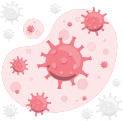Definition
Hyperandrogenism is a condition in which the body produces an excess of androgen hormones, resulting in elevated levels in the blood. Androgens are a group of sex hormones produced by both male and female reproductive organs, as well as the adrenal glands situated above the kidneys.
In men, these hormones play a role in developing and maintaining male sexual characteristics, such as deepening of the voice, and the growth of facial, chest, underarm, and genital hair, as well as sperm production. Women also produce androgens, albeit in smaller amounts. In women, androgens are converted into estrogen (female sex hormone) and contribute to sexual arousal and desire.
Hyperandrogenism is rare in men. In women, it is primarily caused by polycystic ovary syndrome (PCOS). The most common symptom of PCOS is hirsutism, characterized by excessive hair growth in specific areas of the body.
Causes
Here are some causes of hyperandrogenism in women:
Polycystic Ovary Syndrome (PCOS)
This condition is the most frequent cause of hyperandrogenism, affecting about 10% of women of reproductive age. The exact cause of PCOS is not well understood. PCOS is marked by:
- Irregular or absent menstrual periods.
- Excessive hair growth on the face and body.
- Acne, especially on the back, chest, and face.
- Overweight or obesity.
- Dark patches of skin in the armpits or skin folds.
- Ovarian cysts.
- Fertility issues, among others.
Menopause
Menopause is not a disease but can be associated with hyperandrogenism. Postmenopausal women experience a decline in female sex hormones (estrogen and progesterone), while androgen levels from the adrenal glands are maintained. This imbalance between androgen and estrogen levels leads to increased androgen levels and associated symptoms.
Ovarian and Adrenal Tumors
Tumors in the ovaries or adrenal glands can lead to increased androgen production. This condition is more common in postmenopausal women. Ovarian tumors are generally benign, whereas adrenal tumors can be either benign or malignant. This cause is rare, accounting for approximately 0.2% of all hyperandrogenism cases.
Non-Classical Adrenal Hyperplasia
This condition is characterized by excessive androgen production by the adrenal glands. Symptoms may include irregular periods and signs of hyperandrogenism, often leading to misdiagnosis as PCOS.
Risk Factor
Conditions that may cause hyperandrogenism include congenital adrenal hyperplasia and adrenal or ovarian tumors. These conditions are more likely to occur in individuals with a close family history of such diseases.
PCOS is the most common cause of hyperandrogenism. Although the exact cause of PCOS is unknown, several risk factors might contribute to its development:
Insulin Resistance
Insulin is a hormone produced by the pancreas that allows cells to use glucose, the primary energy source. When cells become resistant to insulin, insulin levels rise, potentially leading to increased androgen production. This condition is seen in diabetes mellitus.
Besides genetic factors, insulin resistance is often due to an unhealthy lifestyle, including a high-carbohydrate and high-fat diet and insufficient physical activity.
Inflammation
Normal inflammation is necessary for egg release and growth. In PCOS, excessive production of inflammatory compounds occurs, and chronic inflammation can lead to excessive androgen production.
Genetic Factors
Women with a mother or sister who has PCOS or type 2 diabetes have a higher likelihood of developing PCOS.
Symptoms
Symptoms of hyperandrogenism in women include:
- Hirsutism
Androgens stimulate the growth of coarse, pigmented hair in areas typically seen in men, such as:
-
- Face
- Center of the chest
- Back
- Arms
- Legs
- Genital area
- Baldness
Baldness due to hyperandrogenism typically begins at the crown of the head.
- Obesity
Women with hyperandrogenism often have excess weight or obesity and may find it difficult to lose weight.
- Acne
Androgens stimulate oil production in sebaceous glands, leading to acne, primarily on the face, chest, and back. Acne may persist beyond adolescence and be challenging to treat.
- Menstrual disorders
This includes delayed periods or complete absence of menstruation, potentially causing infertility.
Increased androgen levels can also lead to virilization, where a woman exhibits male-associated traits, such as:
- Deepening of the voice
- Enlarged clitoris
- Increased muscle mass
- Reduced breast size
Diagnosis
To diagnose hyperandrogenism, doctors will conduct a medical interview and a series of tests. The interview includes collecting information about the patient's identity, medical history, age, ethnicity, symptom duration, menstrual history, and family medical history. A physical examination will follow to identify hyperandrogenism symptoms.
Blood tests will be performed to measure hormone levels, primarily testosterone. Elevated free testosterone levels are strongly associated with hyperandrogenism. Additionally, a pregnancy test may be conducted in premenopausal women along with other hormone assessments.
If virilization symptoms or extremely high testosterone levels are detected, radiological examinations may be performed to assess abnormalities in the ovarian or adrenal glands.
- Transvaginal Ultrasound (USG): Typically used to examine the ovaries.
- CT Scan or MRI: Used to examine the adrenal glands.
Management
Treatment for hyperandrogenism varies based on the severity of symptoms and the underlying cause. Generally, hyperandrogenism is managed with medication, while surgery is reserved for ovarian or adrenal tumors.
Medications
- Contraceptives
Oral contraceptives containing ethinyl estradiol can reduce androgen production and levels in the blood, alleviating symptoms such as hirsutism and acne. Other hormonal contraceptives like injectable contraceptives, vaginal rings, and intrauterine devices may also be effective.
- Antiandrogens
Medications such as spironolactone and finasteride may be added to the treatment regimen after six months of contraceptive use to address hyperandrogenism symptoms. These medications should not be used during pregnancy.
- Glucocorticoids
Drugs like dexamethasone can be used to lower androgen production in patients with congenital adrenal hyperplasia.
- Insulin resistance treatment
Diabetes medications like metformin can be used for patients with PCOS who also have diabetes.
Pregnancy Planning
If you plan to conceive, there are treatments available to enhance the likelihood of pregnancy. Consult your doctor about your treatment options. If these treatments are unsuccessful, assisted reproductive technologies such as in vitro fertilization (IVF) may be considered.
Weight Loss
In addition to medication, weight loss in obese women with PCOS can reduce testosterone levels and improve hyperandrogenism symptoms. However, lifestyle changes alone have limited efficacy in managing hyperandrogenism and should not be the sole approach.
Complications
- Fertility and pregnancy
Women with hyperandrogenism may experience ovulation disorders, which can manifest as delayed periods, absent menstruation, or heavy bleeding. Infertility is also a possibility, and pregnant women with hyperandrogenism are at higher risk for miscarriage.
- Cosmetic issues
Symptoms like excessive body hair, baldness, obesity, and acne can impact self-esteem and cause psychological issues.
- Cardiovascular risks
Hyperandrogenism is linked to serious cardiovascular conditions, including high blood pressure and heart disease.
- Metabolic complications
Insulin resistance and elevated blood lipids may occur, leading to serious metabolic disorders such as type 2 diabetes and cardiovascular diseases.
Prevention
There is no definitive way to prevent hyperandrogenism, as its causes and risk factors are not fully understood and can vary among individuals.
However, regular health check-ups can help mitigate long-term risks, particularly for those with a family history of the condition, irregular menstrual cycles, or diabetes. Lifestyle modifications, including a balanced diet and regular exercise, can alleviate symptoms.
When to See a Doctor?
Consult a doctor if you experience:
- Extremely irregular menstrual cycles.
- Excessive hair growth on the chest, back, face, or genital area.
- Baldness.
- Difficulty conceiving.
You can seek further evaluation to determine whether your concerns are normal or indicative of a specific medical condition.
Looking for more information about other diseases? Click here!
- dr Hanifa Rahma
Cleveland Clinic. (2022). Androgens: Function, Measurement and Related Disorders. Retrieved 9 October 2022, from https://my.clevelandclinic.org/health/articles/22002-androgens#.
Fertilitypedia. (2022). Fertilitypedia - Hyperandrogenism. Retrieved 9 October 2022, from https://fertilitypedia.org/edu/diagnoses/hyperandrogenism#/self_therapy_panel.
Sharma, A., & Welt, C. (2021). Practical Approach to Hyperandrogenism in Women. Medical Clinics Of North America, 105(6), 1099-1116. doi: 10.1016/j.mcna.2021.06.008.
The American College of Obstetricians and Gynecologists. (2020). Screening and Management of the Hyperandrogenic Adolescent. Retrieved 9 October 2022, from https://www.acog.org/clinical/clinical-guidance/committee-opinion/articles/2019/10/screening-and-management-of-the-hyperandrogenic-adolescent.
Konar, H. (2020). DC Dutta's Textbook of gynecology (pp. 481-483). [S.l.]: Jaypee Brothers Medical P.
Sadeghi, H., Adeli, I., Calina, D., Docea, A., Mousavi, T., & Daniali, M. et al. (2022). Polycystic Ovary Syndrome: A Comprehensive Review of Pathogenesis, Management, and Drug Repurposing. International Journal Of Molecular Sciences, 23(2), 583. doi: 10.3390/ijms23020583.
Cleveland Clinic. (2022). Polycystic Ovarian Syndrome (PCOS): What Is It, Causes, Symptoms & Treatment. Retrieved 9 October 2022, from https://my.clevelandclinic.org/health/diseases/8316-polycystic-ovary-syndrome-pcos.
Centers for Disease Control and Prevention. (2020). PCOS (Polycystic Ovary Syndrome) and Diabetes. Retrieved 9 October 2022, from https://www.cdc.gov/diabetes/basics/pcos.html.
Cleveland Clinic. (2022). Hirsutism: What It Is, In Women, Causes, PCOS & Treatment. Retrieved 9 October 2022, from https://my.clevelandclinic.org/health/diseases/14523-hirsutism.
Mayo Clinic. (2022). Congenital adrenal hyperplasia - Symptoms and causes. Retrieved 9 October 2022, from https://www.mayoclinic.org/diseases-conditions/congenital-adrenal-hyperplasia/symptoms-causes/syc-20355205#:~:text=Risk%20factors,genetic%20change%20for%20the%20disorder.
Centers for Disease Control and Prevention. (2022). Ovarian Cancer What Are the Risk Factors?. Retrieved 9 October 2022, from https://www.cdc.gov/cancer/ovarian/basic_info/risk_factors.htm.












